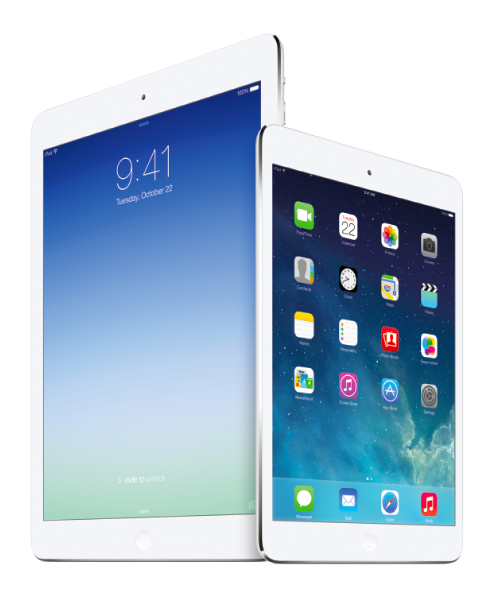With New iPhones And iPads On The Way, Apple Should Offer Lame Duck Model Sales Incentives – The ‘Book Mystique
You don’t need a crystal ball or sophisticated market analytics ability to deduce that iPhone and iPad upgrades are in the pipeline for consumer release by the end of October at the latest. For the past two years Apple has released new iPhone models on September 12 and 10 respectively, in both instances followed by new iPads and iPad minis on October 23, 2012, and October 22, 2013.
Consequently, odds are strong that we’ll see at least one new iPhone 6 model rolled out in September, 2014, with new iPad Airs and a third generation iPad mini around the third week of October. That speculative projection’s credence is enhanced by a report from the Taiwan-based Chinese language Economic Daily News’s Xia Shuxian, who says volume production of the 4.7-inch iPhone 6 has already commenced, and will start up for the 5.5-inch iPhone 6 and the new iPads in September.
If that prognosis proves accurate, it would seem to indicate a staggered release for the two new iPhone models, with Apple rumored to be hoping to avoid a repeat of last year’s less than stellar joint iPhone 5s/5c unveiling. I’m not convinced that it’s such a great idea, and if implemented it sounds like a formula for customer confusion.
GforGames blogger Mihai Matei, who seems to have good sources, predicts that Apple’s next-gen tablets will feature A8 processors and the Touch ID fingerprint sensor, but otherwise won’t depart much appearance-wise from the current iPad mini Retina and iPad Air. Others have forecast that they will also get an upgrade to the 8 megapixel cameras from the iPhone 5s.
He also cites a prediction from KGI Securities Apple-Warcher analyst Ming-Chi Kuo that the iPad mini with Retina Display will replace the A5-powered 1024 x 768 resolution original iPad mini as the entry level mini model at a reduced price once the new generation ‘Pads are launched.
Mihai Matei expresses skepticism about how much Apple would be able to reduce the A7 Retina resolution panel mini’s price, but suggests that if Apple can figure out a way, the mini would give other 7-8-inch tablets a run for their money specs-wise with less of a price premium to overcome.
All of which makes buying any current generation iPad or iPhone at full retail list right now a questionable strategy if you can manage to hold out with your present hardware for another two or three months.
Which is why sales of Apple mobile devices tend to tail off significantly around the ninth month of their production run. Informed buyers know new models are typically released at roughly 12- month intervals, usually bringing with them substantial power and features enhancements at the same or sometimes even lower, or st least better-value prices.
And as somebody commented in a forum post that caught my eye, “it just seems silly to have your company look basically dead all year and have everything of any interest announced in one hit, when other companies look like they are bringing new and exciting things out at many times during the year.”
A fair observation. Apple gets away with it because their products are so strong in their own right that they keep selling reasonably well throughout the year anyway, but those of us cognizant of Apple product release cycles do tend to keep the plastic in our wallets during the months running up to what are fairly dependably annual major product upgrades or new product announcements.
For example, last fall savvy iPad buyers who waited for the iPad Air release got machines roughly twice as fast with 64-bit support as well as being smaller and lighter, for the same money as the 4th-generation iPad would have cost them right up to the announcement day. Patient iPad mini buyers did even better, gaining a Retina resolution display and a processor some five times faster than the preceding original iPad mini.
That said, I’m not expecting anything like last year’s performance improvement factors in moving to A8 silicon from the A7 SoC, and folks who can’t wait will fare better in terms of buyer-remorse this year than they would have 12 months ago. The A7 powered machines are very nice pieces of work with plenty of power for future-proofing.
I’m debating myself whether to stick with the old iPad 2 for another three months, or go for an A7 unit. IMHO, Apple would be able to even out the peaks and valleys of mobile device sales by offering sales incentives in the run-up months before new model releases, which could be in the form of memory or 4G upgrades thrown in, cash discounts, rebates, or Apple Store gift cards.
For iPads, a $75 discount off the mini and $100 off the Air would be nice, but likely wildly unrealistic. However, even $50 off retail list would possibly be enough to tempt me to move now rather than later, especially on a mini. I’m not holding my breath.
Speaking of prices,there’s also the question of whether Apple might lower iPad price points, which have remained the same for full-sized units since their introduction in 2010, in aid of blunting some of the Android competition’s pricing edge. For Canadians like me, there’s also always potential for exchange rate fluctuations. Currently, Canucks pay a nominal dollar figure $20 premium over U.S. List prices (ie: Can$519 vs. US$499 for the base iPad Air), but paid in dollars that have been trading in the US$.92-$.93 range for the past couple of months. Sometimes it’s hard to figure out whether you’re ahead or behind.


